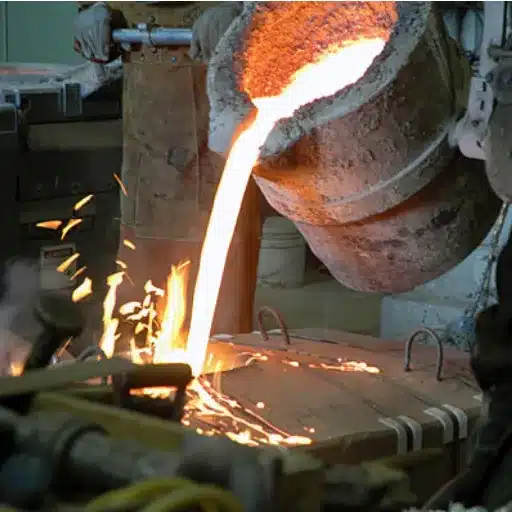Undeniably, stainless steel cookware is a common household fixture due to its sleek design, durability, and high functionality while cooking. Nevertheless, even the best cookware requires proper handling and maintenance. Rotting, stubborn stains, and warping are some of the issues that can come from improper care. This article focuses on how meticulous stainless steel cookware users are and highlights the numerous pointers that can help in the long term. It does not take a culinary expert to need stainless steel cookware; however, the right techniques ensure the investment made is worthwhile.
What Causes Stainless Steel to Rust and Corrode?
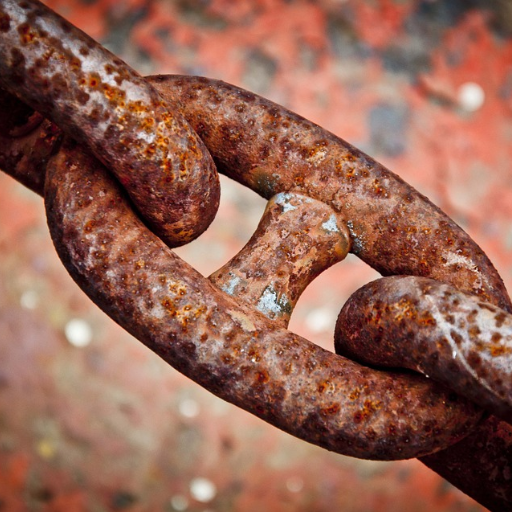
Stainless steel can corrode or get rusty when the protective chromium oxide layer gets damaged. Protective shields get weak due to spending too much time in moist areas, contact with salt, or acidic food. Use of dangerous industrial-strength chemicals or abrasive scrubbing pads can weaken the protective layer. Proper washing, along with correct drying technique, should be followed in order to prevent damage and rust while increasing durability.
How Exposure to Chloride Damages Stainless Steel
Chloride exposure is one of the most important factors leading to the degradation of stainless steel. Molybdenum starkly increases the resistance of stainless steel against chloride-induced corrosion, which is why 304 grade stainless steel is more vulnerable than 316. For instance, studies demonstrate that stainless steels are most at risk in environments with elevated rates of chlorides, particularly exceeding 200 parts per million (ppm). To minimize harm, maintaining lower grade stainless steel is essential to prevent accumulating residues, which would worsen corrosion in a chloride-rich environment. Moreover, the suitable grade of stainless steel should be tailored for highly charged chloride applications. Over time, chlorides, including saltwater or hydrochloric acid cleaning agents, are able to breach the oxide layer of protective chromium, which results in pitting or crevice corrosion. Cleansing also becomes essential in delaying surface residue that causes stainless steel to degrade rapidly.
Why Plain Steel Contaminants Lead to Rust on Stainless Steel
Whenever stainless steel makes contact with plain steel, contamination might happen, which causes rust to form. This occurs because plain steel does not have chromium to give stainless steel its resistance against corrosion. The iron particles from a plain steel surface can infest a chrome layer. Chrome, oxide and stainless steel have chrome particles which prevent moisture and oxygen alloying copper from inhibiting further oxidation. Bared, they cause conventional galvanic corrosion in the protected iron pound lock.
Contaminants like plain steel can speed up rusting even in small quantities, especially for humid and salty weather. For example, during industrial work, the spread of contaminants takes place during fabrication processes which include cutting and brushing using tools stuck with plain steel. Regular contact, insufficient cleaning, or maintenance tends in analytical data towards exacerbating extensive rusting. To counter those recommendations, the tools designed for working with steel should be cleaned to free the traces of plain steel.
Understanding How Scratches Break Down the Protective Layer
Scratches on stainless steel can damage its protective chromium oxide layer. This layer of the stainless steel prevents corrosion by protecting the steel from moisture and oxygen. Bare steel exposed by the scratch is vulnerable to oxidation and rust. Proper maintenance aids in the preservation of the protective layer, which requires avoiding abrasive tools and promptly addressing scratches.
Is Your Cleaning Routine Damaging Your Stainless Steel Sink?
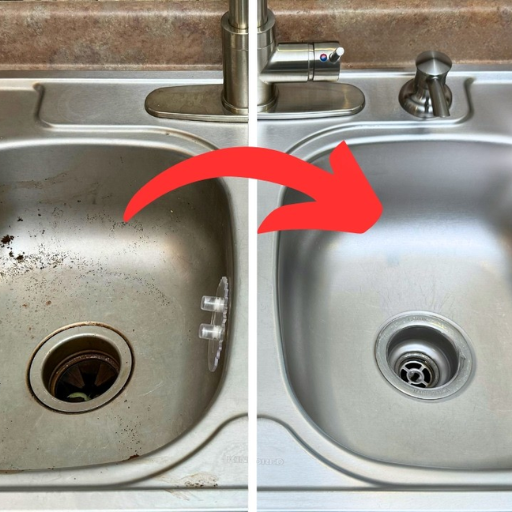
As with many things in life, routine is helpful too. Though your cleaning regimen may be harming your stainless steel sink, depending on the methods or tools used. You might be using harsh cleaning abrasive cleaners that consist of steel wool and scrubbing pads, which may cause scratches that can compromise the protective cover and result in corrosion and rust. If you want to avoid damage, use non-abrasive cleaners, soft cloths or sponges, and always clean in the direction of the grain on the stainless steel. Keeping a regularly maintained, gentle method of cleaning may extend the life and improve the aesthetics of the sink.
Why Steel Wool and Abrasive Cleaners Cause Permanent Scratches
Cleaning stainless steel sinks with steel wool or abrasive cleaners is extremely destructive because these tools have sharp particles and coarse textures. Stainless steel sinks depend on a thin protective oxide layer to stave off rust and corrosion. The use of harsh cleaning tools and cleaners abrades the protective layer, which leaves the metal underneath open to air and moisture. Ultimately, this leads to the creation of permanent scratches and increases the sink’s propensity to stain and rust. Research suggests that stainless steel with greater chromium content possesses a stronger oxide layer, but even this boosted defense can be eroded by the use of abrasive materials. To ensure the surface is not compromised, it is best to pair pH-neutral and nonabrasive cleaners with microfiber cloths and soft sponges. These approaches guarantee the sink does not suffer damage while maintaining its brilliant shine.
How Bleach and Harsh Chemicals Lead to Pitting Corrosion
When the protective oxide layer of stainless steel surfaces is destroyed by bleach or other harsh chemicals, pitting corrosion takes place. The protective layer upon which the oxide rests, once compromised, gives rise to small pits that can deep excavate over time, weakening the material. This is why I do not use chlorine-based cleaners; instead, I use pH-neutral, mild cleaners to protect the stainless steel surface.
The Impact of Letting Water Spots Sit on Stainless Steel
Although water spots may appear inconsequential in the beginning, on stainless steel surfaces, they can remain unattended, amplify staining, discoloration, and even inflict enduring damage. These marks are caused by the mineral composition commonly found in hard water. The harder the water is, the more harsh calcium and magnesium minerals that are present will accumulate over time, resulting in building up a dull deposit on the shiny surfaces. Research suggests that hard water, with its high levels of calcium and magnesium, increases the damage done by residue left over. Moreover, the presence of moisture combines with water seeping into tiny gaps on the stainless steel surfaces to trigger corrosion, which accelerates degradation. Regularly polishing stainless steel surfaces to remove excess moisture with a microfiber towel and cleaning with distilled water alleviates corrosion while enhancing steel’s sturdiness and visual charm.
How High Heat Can Damage Stainless Steel Pans
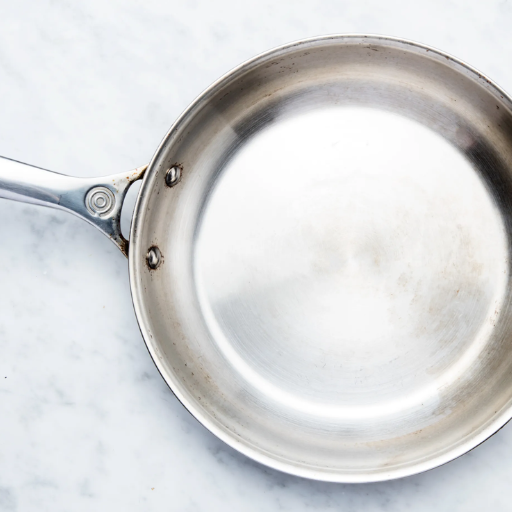
Stainless steel pans are prone to damage like discoloration, warping, and pitting at very high temperatures. Staining, which is characterized as a rainbow-like sheen occurring at the surface, happens as a result of reacting with stubborn metal. Also, high temperatures can make the surface of the cookware susceptible to pitting or corrosion (causing small holes). Excessive temperatures can result in uneven heat distribution, which may lead to warping of the pans over time. In order to retain the safety of these pans, make sure not to use the extreme heat settings, and allow lower temperatures to be gradually.
Why Preheating Empty Stainless Steel Cookware Causes Warping
Preheating stainless cookware without any contents causes the rapid and uneven rise of temperature, which may cause thermal expansion. This means the metal expands and heats up at different rates across the pan, particularly if the heat source or material is not consistent. With time, these differences in heating and cooling will cause inconsistent expansion, which in turn will lead to warping. In the case of stainless steel, it has been shown that it will begin to distort over 500°F (260°C) without food or liquid present to absorb and redistribute the heat. For example, some studies have shown that putting oil or water into the pan prior to preheating greatly improves the situation by changing the heat transfer mechanism, which reduces the chance of warping. Thus, to maintain the performance and durability of stainless steel cookware, do not let the cookware sit empty on a high flame.
How Adding Salt to Cold Water Creates Pitting in Stainless Steel Pans
The addition of salt to cold water in stainless steel pans can cause ‘pitting corrosion.’ While pitting corrosion is often associated with a lack of oxygen, it has been shown that-under certain conditions, it can also occur in oxygen-rich environments. Pitting simply refers to the creation of small holes in the surface of an object, while corrosion is the process of deterioration of the material as a result of chemical reactions. Overall, it can be said that pitting corrosion occurs when a nonuniform oxide layer is developed on an object. Pitting can occur where there is a purged oxide layer that is more reactive than the underlying metal.
Research suggests that these pits are a result of the breakdown of the passive oxide layer of chromium that forms on stainless steel. The exposed parts of the steel will undergo corrosion. A good example is laboratory research that shows the addition of salt while water is cold enables the undissolved pieces of salt to freeze and stingers in front of the metal surface, facilitating significant pitting damage.
To avert this, it is best to add salt only after water has been heated or brought to a boil. The salt will dissolve more quickly and uniformly in hot water, which lessens the chances of it settling on the surface of the pan. This straightforward measure can help extend the useful life of your cookware while sustaining its condition over time.
Understanding Rainbow Stains and Heat Damage on Stainless Steel
Rainbow stains on stainless steel cookers are often referred to as ‘interference coloring’ and are caused due to a layer of heat-induced oxide coating on the steel surface which subsequently refracts light. Although such marks do not pose any harm, they certainly distort the visual appeal of your kitchenware. These stains can be easily dealt with using discolored vinegar mixed with water. It is important to use a soft cloth or sponge so as not to scratch the surface.
Stainless steel cookware is capable of withstanding high temperatures, however, heat damage can be a more serious concern. It is important to note that while stainless steel cookware can withstand high temperatures, overheating it can result in warping, discoloration, and reduced structural integrity. Empirical evidence suggests that heating stainless steel cookware to temperatures exceeding 500°F (260°C) results in non-boiling water leading to severe surface alterations and reactive properties. To avoid this, it is best to use low and medium settings when applicable and to preheat stainless steel cookware. Moreover, letting cookware cool down before washing aids in maintaining the cookware’s protective features. Proactively addressing these concerns with effective maintenance solutions means a stainless steel set can be retained in ideal condition for years.
What Acidic Foods Do to Your Stainless Steel Cookware?
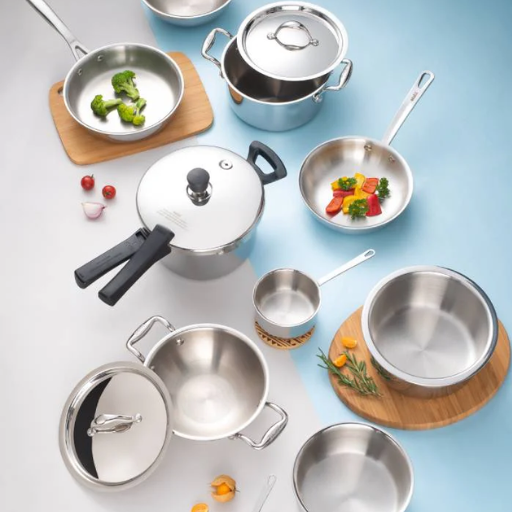
Stainless steel cookware can accumulate markings or even some pitting over time due to cosmetic damage. Acidic foods like tomatoes, citrus fruits, and vinegar can lead to this. Keeping acidic substances in contact with the surface of the cookware can cause the cookware’s surface to react over time, leading to these signs of aging. Although this fading does not impact performance or safety, not keeping acidic foods in the cookware for extended periods would be optimal. Remember to clean them after every use so you can maintain the aesthetics.
How Tomato and Citrus Can Pit Stainless Steel When Left Sitting
Tomatoes and citrus fruits possess natural acids; lemons and oranges have citric acid while tomatoes have malic and citric acid. When having prolonged contact with stainless steel, these acids can weaken the protective chromium oxide layer which inhibits corrosion. It has been shown that exposing stainless steel to high acid food for long periods of time can create minor etching or pitting in lower grades of stainless steel.
Take 304 stainless steel as an example. It is a popular stainless steel grade. 304 is very resistant to corrosion, but not completely under some circumstances. If left stagnant at room temperature for hours, acidic food can interact with the metal surface. After some time, this can lead to dull and pitting damage, which is exacerbated by micro-abrasions in seams or more advanced areas.
To keep your cookware in good shape, it’s a good idea to move acidic foods like tomato sauce and citrus-based marinades into glass or ceramic storage containers right after cooking. Loved one that the stainless steel cookware is cleaned immediately after use with warm soapy water, which aids in preservation of the stainless steel’s shine, and extends the cooking utensil’s lifespan. Moreover, maintenance once in a while, like stainless steel polish, will restore its luster and add strength to the protective coating on the stainless surface.
Why Vinegar-Based Marinades Might Damage Lower Grade Stainless Steel
Vinegar-based marinades are known to contain acetic acid, which can react readily with chromium oxide, a layer that helps stainless steel resist corrosion. The protective layer is weakened further by pitting of lower grade stainless steel, like those with less than 10.5% chromium content, making them especially vulnerable to this reaction. If the cookware is exposed to acids for too long, they may suffer pitting or surface corrosion.
Research focusing on the composition of stainless steel indicates that 304 and 316 have higher nickel and chromium content, leading to stronger resistance to acidic environments; however, lower grades like 201 and 202 were found to be more susceptible to corrosion. During cookware testing, 201 grade stainless steel suffered visible corrosion after soaking in a 5% vinegar solution for just 24 hours. This is in contrast to 304 grade stainless steel, which didn’t corrode at all. Higher levels of chromium and nickel substantially improve corrosion resistance.
To reduce the risk of damaging corrosive cookware, it is best to limit exposure to acidic marinades, clean after every use, and refrain from using lower grades of stainless steel. These recommendations maximize the ability of cookware to endure acidic ingredients while preserving effectiveness and lifespan.
Are You Using the Right Products to Clean Your Stainless Steel Appliances?
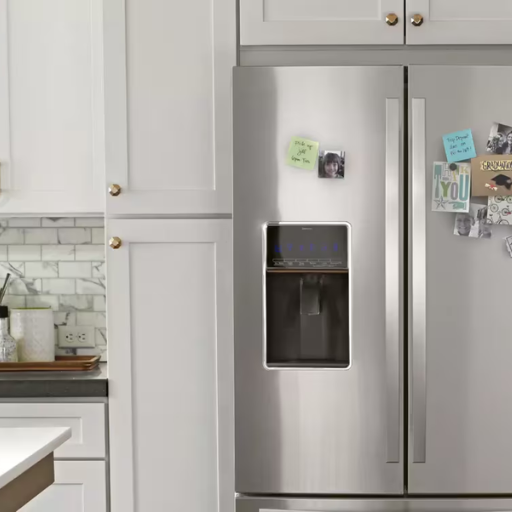
For proper cleaning of your stainless steel appliances, non-abrasive products such as mild dish soap with warm water should be used. For regular maintenance, dish soap and warm water work best. Strong stains or fingerprints can be cleaned with water mixed with white vinegar or commercial stainless steel cleaner. Keep in mind to never use harsh chemicals because they will scratch the surface. Always dry with microfiber, to maintain the shine.
When Baking Soda and Vinegar Solutions Are Safe for Stainless Steel
Cleaning stainless steel surfaces and appliances can be done easily and cost-effectively with household items like baking soda and vinegar, if used wisely. They both act as safe cleaning aids while also being effective when combined or when put through chemical reactions. Vinegar’s acidic properties aid in separating water spots, limescale, and even grease, hence, it must be paired with a gentle abrasive such as baking soda. In order to clean safely, it is advised to mix baking soda with water, which can then be applied to the surface using a sponge or cloth. If the stains are more stubborn, white vinegar can then be combined with water, mixed in a 1:1 ratio, which can then be sprayed accordingly.
When cleaning, it’s of utmost importance to rinse the steel surface thoroughly with water after cleaning. If left over time, vinegar’s harsh properties can alter the stainless steel surface by leaching onto the oxide protective layer, instantly causing corrosive damage. These two household essentials, when paired correctly, give an efficient, eco-friendly solution to cleaning appliances while saving both time and money. Further, make sure to test the conditions on surfaces to avoid ruining the stainless steel’s finish.
Why Cleaning Against the Grain Causes Visible Scratches
The surfaces of stainless steel are manufactured with a brushed or polished finish which generally features small grooves or lines, commonly referred to as “grain.” When cleaning stainless steel, surfaces brushed against the grain can lead to these grooves getting clogged with dirt, debris, and grime. Over time, these fine scratches that get embedded become visible, especially on polished finishes.
Further, gathered quantitative evidence suggests that scratches on stainless steel become more common due to the K-use of rough cleaning implements like scouring pads and abrasive sponges. To keep the stainless steel looking new, specialists advise cleaning with soft microfiber cloths while avoiding the ingrained dirt. This approach minimizes the chance of scratches and ensures more effective streak removal, resulting in a cleaner polish.
How to Choose Non-Abrasive Cleaners for Different Stainless Steel Finishes
The choice of stainless steel non abrasive cleaner should be inline with the specific finish of your stainless steel surface because each finish has its own set of needs to aid in retaining its beauty and longevity. For brushed and satin finishes, a cleaner with a gentle formula and warm water is usually enough. Grease and grime can be washed away by dish soap mixed with water without scratching. Studies claim that more than 70% of homes with stainless steel appliances have brushed finishes, highlighting the need for gentle cleaning solutions.
A vinegar-water solution with one part vinegar to three parts water is very popular for polished or mirrored finishes as it removes fingerprints, water spots, and smudges without destroying the polish. Research has shown vinegar-based solutions are one of the cheapest, eco-friendly options, which makes them an attractive choice for green households.
To avoid streaks, the final step after cleaning should be drying the surface with a clean, non-abrasive microfiber towel. There are also stainless steel sprays and wipes designed for different finishes that claim to improve the shine and protect the surface for a long time. Always conduct product compatibility tests on non-visible areas to ensure it won’t damage your finish type.
What Hard Water Does to Stainless Steel Fixtures
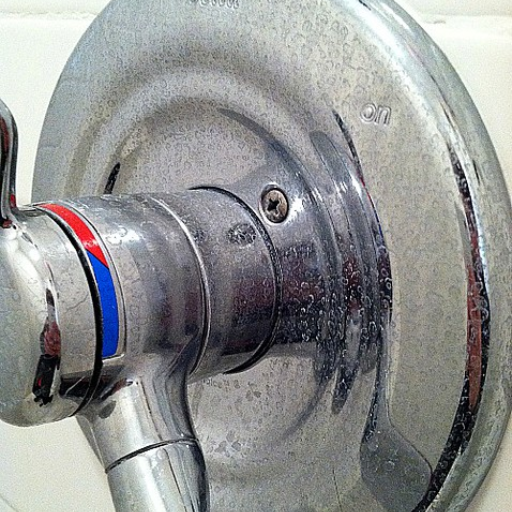
Stainless steel water fixtures may show stubborn stains, dulling, or discoloration because of hard water. This form of water has a higher concentration of minerals like calcium and magnesium, which leave a chalky and white residue after evaporating. If left unmaintained, the chalky and white residue may corrode, becoming increasingly difficult to clean over time. To reduce corrosion, regularly clean the stainless steel with gentle soap and wipe the fixtures dry after use.
How Mineral Deposits Create Stubborn Stains on Stainless Steel
The deposits result from the evaporation of hard water, which leaves behind minerals such as calcium carbonate and magnesium. It has been reported that water with a hardness of above 120 mg/L is likely to cause scaling on the surfaces of stainless steel. If left untreated, dulling, discoloration, and surface pitting can occur over time.
To deal with the challenges posed by hard water, the use of water softening systems or descaling agents to reduce mineral content has been recommended. Periodic cleaning with acetic acid, better known as vinegar, will eliminate mineral deposits, restoring the original shine to stainless steel. Furthermore, adopting simple daily maintenance like drying surfaces after use, as well as refraining from the use of harsh cleaning materials, goes a long way in extending the life of the stainless steel fixtures.
Why Tap Water Can Leave Water Stains on Stainless Steel
The stains that can appear on stainless-steel surfaces may be caused by tap water. It contains dissolved minerals such as calcium and magnesium, the latter usually found in hard water. “Hard water” is commonly used to describe indiscriminate accumulations of minerals. When water evaporates, it leaves behind some residue, and these surfaces can be affected by such residues. Research suggests that the presence of hard water increases the level of noticeable staining. Water hardness is typically gauged in grains per gallon or ppm (parts per million). For instance, hard water is classified as anything above 120 ppm. That is the level at which water becomes unyielding and incapable of getting soft, while the liquid itself poisons steel. In addition, increased silica content of the water worsens things by forming marks in the glass or clouded surfaces, which are very difficult to clean off. Being aware of where you live and what hardness levels water offers, alongside taking the right precautions, can mitigate the potential damage these residues can cause, aiding steel in looking sleek and polished.
Best Practices for Preventing Hard Water Damage
- Use Water Softening Systems
Fighting hard water problems? Consider installing a water softener. They soften hard water during the ion exchange process which replaces calcium and magnesium ions with sodium and potassium ions. This lessens the mineral deposits on steel appliances. Studies show households with water softeners experience 50% less mineral stains and sediment when compared to households without.
- Clean Regularly with Suitable Products
Using stainless steel safe products makes surface-level cleaning easier and eliminates a lot of hard water stains. For the best results, use mineral cleaner products or vinegar mixed with water. Studies show vinegar’s main ingredient, acetic acid, breaks down calcium deposits and doesn’t corrode metals.
- Dry Surfaces Immediately
Stainless steel surfaces should be dried with a soft cloth after they are cleaned. This is done to minimize the chance of water evaporating and leaving spots behind. This step is key as softened water can leave traces on surfaces if too much time is spent without being wiped down.
- Apply Protective Coatings
Applying a coating or polish on a stainless steel surface helps to repel water while preventing mineral deposits from building up. These coatings act as shields which help surfaces remain streak-free for longer periods of time. A survey conducted on appliance users showed that using coatings helped reduce visible water stains by as much as 30%.
- Monitor and Maintain Appliances
Periodically descale water-using appliances like dishwashers and coffee makers to keep internal components from clogging. Depending on the hardness of the water, many manufacturers suggest descaling these units every 1 to 3 months. Sticking to this schedule helps boost unit lifespan and operational efficiency by avoiding damage due to hard water clogs.
Incorporating these strategies will help you control hard water issues while preserving the cleanliness of stainless steel surfaces and appliances over time.
Reference Sources
- Corrosion in Additively Manufactured Stainless Steels1:
- Key Findings: Additive manufacturing (AM) introduces unique microstructural features like porosity, melt pool boundaries, and residual stresses, which significantly influence corrosion resistance. For instance, selective laser melting (SLM) often results in finer microstructures that can enhance passivity in neutral chloride environments but may also promote active dissolution in oxidizing acids.
- Methodology: This review synthesized data from various studies, highlighting the impact of AM-specific defects and microstructures on corrosion behavior. It also identified gaps in research, such as the need for long-term performance studies and the effects of residual stresses.
- Damage Evolution in Additively Manufactured Stainless Steel3
- Key Findings: Porosity distribution plays a critical role in fracture mechanisms. Specimens with large, inhomogeneous voids exhibited flaw-dominated failures, while annealed specimens with low porosity showed fracture behaviors similar to wrought metals.
- Methodology: In situ tensile tests coupled with Synchrotron Radiation micro-Tomography were used to track damage evolution and analyze pore morphology under stress.
Frequently Asked Questions (FAQs)
Q: What are the best ways to clean stainless steel cookware after cooking?
A: The best way to clean stainless steel cookware is to let it cool slightly before cleaning, then wash with warm, soapy water using a non-abrasive sponge or cloth. For stubborn, stuck-on food, fill the pan with water and a drop of dish soap and bring to a simmer for about 10 minutes. Avoid steel brushes or harsh cleaning products as they can scratch the surface. Always dry your cookware thoroughly after washing to prevent water spots, and occasionally use a stainless steel polish to maintain its shine. Remember to clean in the direction of the grain for best results.
Q: How do I care for your stainless steel pots and pans to make them last longer?
A: To extend the life of your stainless steel pots and pans, always preheat before adding oil, avoid dramatic temperature changes, use appropriate utensils (wood, silicone, or nylon instead of metal), and clean properly after each use. Don’t use the dishwasher frequently as harsh detergents can dull the finish over time. Store them properly, either hanging or neatly stacked with protective layers between them to prevent scratches. Regular maintenance with a suitable stainless steel polish can help maintain the appearance and protective properties of the steel alloy.
Q: What makes stainless steel rust or discolor, and how can I prevent it?
A: Despite its name, stainless steel will resist corrosion but isn’t completely stain-proof. Discoloration often occurs due to high heat (blue or rainbow marks), salt exposure, or prolonged contact with acidic foods. To prevent these issues, avoid overheating pans (use medium heat), don’t add salt to cold water in your cookware, clean promptly after use (especially after cooking acidic foods), and dry thoroughly to prevent water spots. Calcium buildup from hard water can also cause white spots or cloudy appearance, which can be removed with a vinegar solution. Regular cleaning and proper care will help maintain your stainless steel’s appearance.
Q: What are the most common mistakes when using stainless steel cookware?
A: Common mistakes include not preheating properly before adding food (causing sticking), cleaning with abrasive materials like steel wool that scratch the surface, using excessive heat (causing warping and discoloration), adding cold ingredients to a hot pan creating thermal shock, using metal utensils that can scratch the surface, soaking for too long in harsh chemicals, not drying thoroughly after washing, and using the wrong cleaning techniques or products. Also, putting hot stainless steel directly into cold water can cause warping. Proper use and care will significantly extend the life of your stainless steel cookware.
Q: How do I keep my stainless steel cookware from sticking when cooking?
A: To prevent food from sticking to stainless steel, follow these steps: 1) Start with a clean pan, 2) Preheat the pan on medium heat for 2-3 minutes, 3) Test if it’s ready by sprinkling a few drops of water—if they bead up and dance, your pan is ready, 4) Add oil and let it heat until it shimmers, 5) Only then add your food. Also, ensure food is at room temperature, not straight from the refrigerator. Don’t flip food prematurely—it will release naturally when a crust forms. For delicate foods like eggs or fish, consider using a bit more oil. This technique creates a natural non-stick surface without damaging your cookware.
Q: How can I restore the shine to my stainless steel sinks and cookware?
A: To restore shine to dull stainless steel sinks and cookware, first clean with a mild dish soap to remove grease and residue. For polishing, you can use vinegar on a soft cloth and buff in the direction of the grain. Baking soda makes an excellent, gentle abrasive for removing stubborn stains without scratching—make a paste with water and use a soft cloth. For a deeper clean, commercial stainless steel polish provides excellent results. Club soda, olive oil, or even glass cleaner can also work well for bringing back the shine. Always finish by buffing with a dry microfiber cloth for a streak-free finish.
Q: What cleaning tips should I follow to remove burnt food from stainless steel pots?
A: To remove burnt food from stainless steel pots, first soak the pan in hot soapy water for at least 30 minutes. For stubborn, stuck-on food, create a cleaning solution by adding equal parts water and vinegar to the pan, bringing to a boil, then removing from heat and adding 2 tablespoons of baking soda (it will fizz). Let it sit for several hours or overnight. Alternatively, sprinkle baking soda liberally on the burnt areas, add a small amount of water to create a paste, and let it sit. Use a non-abrasive scrubber or sponge to gently work away the loosened food. For extremely stubborn spots, a product specifically designed for stainless steel cleaning might be necessary.
Q: How can I make your stainless steel last longer in a busy kitchen?
A: To extend the life of stainless steel in a busy kitchen environment, develop good habits like using appropriate heat settings (medium to medium-high is usually sufficient), allowing pans to cool before washing, using proper utensils (avoid metal when possible), and cleaning promptly after use. Store cookware properly to prevent scratches and dents. Don’t use your stainless steel pots and pans for food storage, especially acidic foods. For busy kitchens, consider having dedicated pans for certain cooking techniques—some for high-heat searing, others for gentler cooking methods. This strategy, combined with proper cleaning and maintenance, will help your stainless steel cookware last for decades.
Q: What types of stainless steel are best for kitchen cookware?
A: The best types of stainless steel for cookware are those with grade markings of 18/10, 18/8, or 304, which indicate the percentage of chromium and nickel in the steel alloy. These higher grades are more resistant to corrosion and staining. For superior performance, look for tri-ply or multi-ply construction where stainless steel encases an aluminum or copper core for better heat distribution. Fully clad cookware has this layering throughout the entire pot or pan, while disc-bottom cookware has it only on the base. Surgical-grade stainless steel (316 grade) is even more corrosion-resistant but typically more expensive. When purchasing new stainless steel cookware, these quality indicators are more important than brand names for ensuring longevity and performance.
Q: How often should I polish my stainless steel kitchen appliances and cookware?
A: You should polish your stainless steel kitchen appliances approximately once a month for areas with frequent use or exposure to fingerprints, like refrigerator doors and dishwashers. For stainless steel cookware, polishing 2-4 times a year is typically sufficient, though this depends on usage frequency. If you notice water spots, dulling, or light discoloration, it’s time for a polish. Always clean the surface thoroughly before applying any polish. For daily maintenance, wiping with a microfiber cloth dampened with water is usually sufficient. When using a commercial stainless steel polish, apply it in the direction of the grain for best results. Regular polishing not only maintains appearance but also helps preserve the protective chromium oxide layer that makes stainless steel corrosion-resistant.

